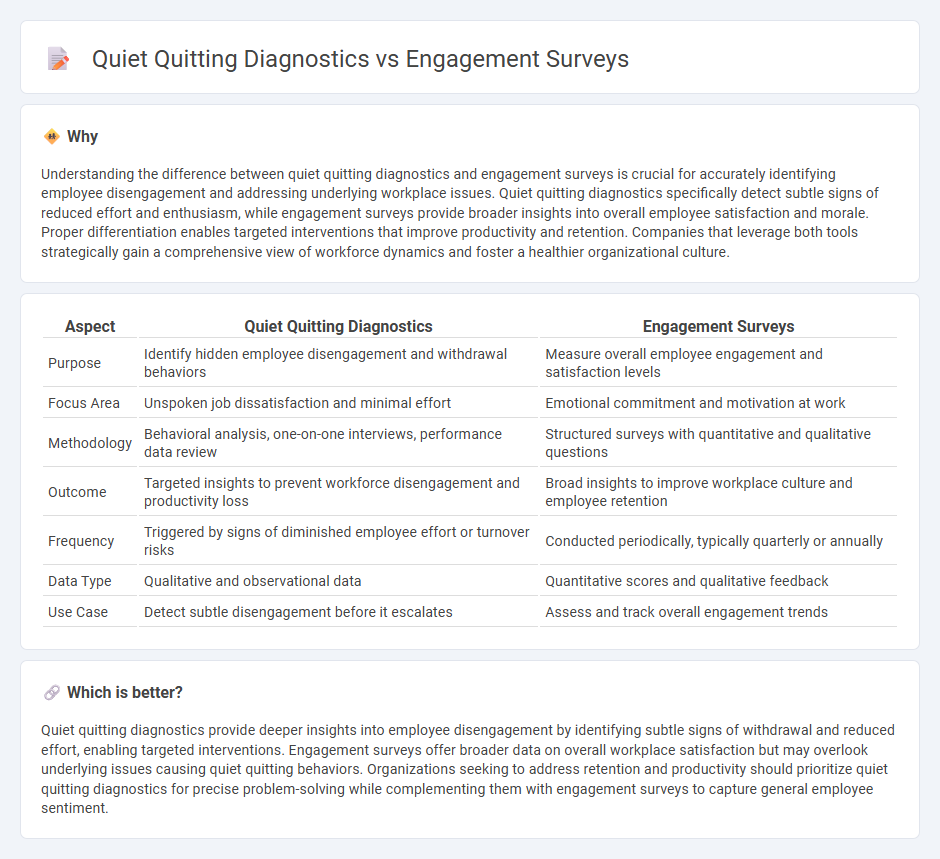
Consulting in the realm of quiet quitting diagnostics focuses on identifying subtle employee disengagement patterns that traditional engagement surveys often miss. While engagement surveys measure overall job satisfaction and morale, quiet quitting diagnostics delve deeper into behavioral signals and productivity changes indicating hidden workforce dissatisfaction. Explore our approach to uncover these critical insights and enhance organizational performance.
Why it is important
Understanding the difference between quiet quitting diagnostics and engagement surveys is crucial for accurately identifying employee disengagement and addressing underlying workplace issues. Quiet quitting diagnostics specifically detect subtle signs of reduced effort and enthusiasm, while engagement surveys provide broader insights into overall employee satisfaction and morale. Proper differentiation enables targeted interventions that improve productivity and retention. Companies that leverage both tools strategically gain a comprehensive view of workforce dynamics and foster a healthier organizational culture.
Comparison Table
| Aspect | Quiet Quitting Diagnostics | Engagement Surveys |
|---|---|---|
| Purpose | Identify hidden employee disengagement and withdrawal behaviors | Measure overall employee engagement and satisfaction levels |
| Focus Area | Unspoken job dissatisfaction and minimal effort | Emotional commitment and motivation at work |
| Methodology | Behavioral analysis, one-on-one interviews, performance data review | Structured surveys with quantitative and qualitative questions |
| Outcome | Targeted insights to prevent workforce disengagement and productivity loss | Broad insights to improve workplace culture and employee retention |
| Frequency | Triggered by signs of diminished employee effort or turnover risks | Conducted periodically, typically quarterly or annually |
| Data Type | Qualitative and observational data | Quantitative scores and qualitative feedback |
| Use Case | Detect subtle disengagement before it escalates | Assess and track overall engagement trends |
Which is better?
Quiet quitting diagnostics provide deeper insights into employee disengagement by identifying subtle signs of withdrawal and reduced effort, enabling targeted interventions. Engagement surveys offer broader data on overall workplace satisfaction but may overlook underlying issues causing quiet quitting behaviors. Organizations seeking to address retention and productivity should prioritize quiet quitting diagnostics for precise problem-solving while complementing them with engagement surveys to capture general employee sentiment.
Connection
Quiet quitting diagnostics identify disengagement signs by analyzing employee behavior and workload expectations, revealing underlying issues affecting productivity. Engagement surveys collect comprehensive feedback on job satisfaction, communication, and workplace culture, providing measurable data to complement quiet quitting insights. Integrating these tools enables consultants to develop targeted strategies that enhance employee motivation and reduce turnover.
Key Terms
Employee Satisfaction
Engagement surveys provide quantitative data to measure overall employee satisfaction, identifying trends in motivation, commitment, and workplace morale. Quiet quitting diagnostics delve deeper into behavioral indicators such as reduced discretionary effort and emotional withdrawal, revealing subtle dissatisfaction that standard surveys might miss. Discover how combining these tools can offer a comprehensive view of workforce well-being and retention strategies.
Turnover Risk
Engagement surveys measure employee satisfaction and motivation levels to identify potential turnover risk, while quiet quitting diagnostics uncover subtle disengagement signs that traditional surveys often miss. Both tools provide crucial data to predict turnover by analyzing behavioral patterns and emotional commitment in the workplace. Explore more about how these approaches can proactively reduce turnover risk and improve retention strategies.
Organizational Commitment
Engagement surveys measure employee enthusiasm and alignment with company goals, capturing levels of Organizational Commitment through direct feedback on job satisfaction and workplace environment. Quiet quitting diagnostics identify subtle signs of disengagement by analyzing behavioral patterns such as reduced effort and minimal discretionary work, highlighting underlying issues in employee loyalty and commitment. Explore detailed strategies to enhance Organizational Commitment by leveraging both tools for a comprehensive workforce analysis.
Source and External Links
10 Key Benefits of Employee Engagement Surveys - Employee engagement surveys are questionnaires that measure how engaged, motivated, and satisfied employees feel, providing leadership with actionable insights to improve company culture and employee experience.
The 10 biggest benefits of employee engagement surveys - These surveys help organizations gain concrete data on employee sentiment, identify areas for targeted improvement, and track engagement trends over time, enabling informed, strategic decisions for workplace enhancement.
45 Proven Employee Engagement Survey Questions - Employee engagement surveys come in various forms--annual, pulse, and lifecycle--each offering unique insights to help organizations respond quickly to concerns and foster a more engaged workforce.
 dowidth.com
dowidth.com